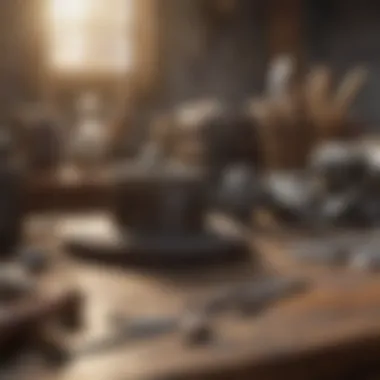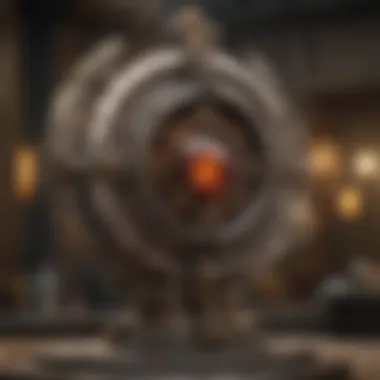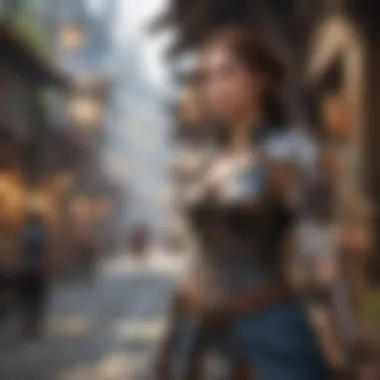Mastering Crafting Strategies in Guild Wars 2


Intro
Crafting in Guild Wars 2 is much more than just combining materials; it’s a core component interwoven throughout the game’s economy and player interactions. Whether a newbie trying to make their first piece of gear or a veteran seeking to master each profession, understanding the intricacies of this system can significantly fortify one's gameplay.
The crafting system offers numerous professions, each with its unique strengths and weaknesses. From Armorsmithing to Cooking, players are not just making items; they are contributing to, and oftentimes driving, the marketplace with their skills. Moreover, by diving into crafting, players can unlock new gameplay avenues, improve their characters, and engage with their peers on a whole different level.
This guide aims to shed light on the various aspects of crafting in Guild Wars 2. Let’s explore how to maximize crafting potential while enriching the gaming experience.
Overview of the Crafting System
Guild Wars 2’s crafting system is designed to be accessible yet deep. Players are allowed to pick up to two crafting professions at a time from a variety of choices. These choices can significantly affect how players interact in the game and contribute to the overall economy.
As you delve into the world of crafting, it’s crucial to understand the basic categories:
- Gathering Professions: Professions like Mining and Harvesting allow players to collect raw materials.
- Refining Professions: This includes disciplines like Jeweling and Leatherworking, where raw materials get transformed into usable forms.
- Production Professions: Finally, there's the crafting of actual items—armor, weapons, and consumables.
Each profession has its own progression path, requiring specific materials and ingredients. The sheer diversity offers a distinct flavor to crafting, reflecting not just the player’s crafting prowess, but also their investment in the game.
Essential Materials
Every crafted item in Guild Wars 2 demands certain materials, each serving as the backbone of the crafting system. These materials can be more than just numbers; they represent gathering, strategy, and sometimes even luck. Here's a breakdown of common material types:
- Basic Materials: These are mined metals, harvested plants, or gathered animal parts.
- Crafting Components: Ingredients crafted from basic materials, sometimes including rare finds from the game world.
- Trophies: Unique items earned from defeating bosses or participating in events, often critical for high-level crafting.
Understanding where to find or how to obtain these materials involves getting out into the world of Tyria, venturing into those enchanting and terrifying locations.
Strategies for Effective Crafting
Mastering crafting isn’t simply about collecting items. It involves strategy and forethought. Here are some helpful strategies:
- Level Up Your Professions Thoughtfully: Focus on learning recipes that align with your gameplay or the market demand.
- Market Awareness: Keep an eye on the Trading Post to find out which items are selling well. Prices can fluctuate based on supply and demand.
- Utilize Gathering Tools: Invest in better gathering equipment to maximize your resource collection.
These strategies not only enhance efficiency but also ensure that crafting continues to be a rewarding aspect of your overall gameplay.
Closure
Crafting in Guild Wars 2 is a journey that goes beyond the act of creation. It is about building connections with other players, understanding the economic landscape, and enriching one's in-game experience on multiple fronts. Whether you are crafting to survive, for profit, or simply for the joy of creation, this system plays a significant role in the broader context of the game.
The crafting system is an area where creativity meets strategy. Remember, every crafted piece tells a story, and you are the author.
Understanding the Crafting System
In the vibrant world of Guild Wars 2, crafting stands as a fundamental pillar, connecting players to the game’s broader economy and gameplay mechanics. Understanding the crafting system is like holding a map in a vast, uncharted territory; it guides you to treasures and benefits that can significantly enhance your experience. At its core, crafting isn't just about making items; it allows players to personalize their gear, support the economy, and cultivate a unique identity within the game.
Crafting materials, from basic raw resources to exquisite exotic components, form the backbone of your crafting journey. Familiarity with different crafting professions lets players exploit various aspects of the game, whether they're improving their stats for tougher battles, or simply crafting cuisine that restores health.
What’s more, crafting has a community aspect too. Collaborating with others, sharing recipes, and even trading goods can foster relationships amongst players and form a vibrant social network that amplifies the entire gaming experience. Therefore, grasping the nuances of the crafting system can be the difference between merely being part of the game and truly mastering it.
The Importance of Crafting in Guild Wars
Crafting in Guild Wars 2 yields several advantages that extend beyond the obvious act of creating items. Firstly, it allows players to meet their character’s needs more effectively. Instead of relying solely on drops or marketplace purchases, you can tailor your gear precisely to your needs. For instance, if you require armor that's strong against physical damage but weak against fire, crafting can ensure you have the right stats that bolster your defense just as you want it.
Additionally, crafting provides a sense of achievement. There’s something satisfying about transforming a collection of raw materials into a finely crafted weapon or piece of gear. This process can elevate your connection to the game and provide a rewarding feeling of progression, particularly when you've been grinding through arduous tasks to gather the necessary resources.
An Overview of Crafting Professions
Crafting in Guild Wars 2 encompasses a variety of specialized trades, each offering unique contributions to both gameplay and the game’s economy. Here’s a closer look at the distinct crafting professions:
Armorsmith
The Armorsmith profession allows players to forge heavy armor, granting them the ability to create gear that significantly boosts their survivability. This profession is vital for those who enjoy close combat or wish to tank in group dynamics. The key characteristic of an Armorsmith is the ability to craft various armor sets tailored to different professions. However, while their creations offer excellent defense, the material costs can be steep, requiring players to heavily invest in resource gathering.
Artificer
Artificers focus on crafting magical items such as sigils and weapons. This profession appeals to players who enjoy the thrill of balancing magical attributes with their gear. The unique feature here is the blend of materials needed, often involving both raw and refined substances, which can prove tricky for new crafters. Nevertheless, the ability to create potent weapons makes this profession popular among those who seek to boost their offensive capabilities.
Chef
Chefs provide invaluable services by concocting consumables that enhance stats or restore health. It’s a vital role in the community as well, offering support for raids and events. The appeal of the Chef profession lies in its accessibility; players can gather ingredients from virtually anywhere, making it easy to start cooking up improvements. However, creating high-quality dishes can often take time and experimentation to master the right recipes.
Jeweler
The Jeweler stands out by crafting rings, necklaces, and trinkets, which provide additional buffs and bonuses. This profession is essential for players looking to maximize their character's potential. One major advantage of the Jeweler is that they often require fewer raw materials than other professions, but finding or crafting the exotic materials can present a challenge.
Leatherworker
Leatherworkers create medium armor and accessories, leveraging hide and substances acquired from creatures across Tyria. This profession suits those who prefer agility over raw defense. A noteworthy advantage of leatherworking is the versatility; crafted items tend to support various playstyles. The downside, though, can be the variance in materials required, which may necessitate extensive gathering efforts.


Scribe
Scribes emerge as the less traditional crafting option, molding glyphs and materials essential for guild activities like crafting decorations and siege weapons. They play a unique role in Guild Wars 2, contributing not only items for personal use but also valuable components for guild upgrades. Their niche nature means that demand might fluctuate, leaving players to determine their crafting efforts with careful consideration.
Tailor
The Tailor profession is primarily focused on light armor wearers, such as elementalist or mesmers. Their creations provide excellent bonuses that favor magical effectiveness, making it a top pick for players who wish to boost their spellcasting capabilities. But the Tailor can have its drawbacks, like requiring a diverse range of fibers and materials that might be harder to gather compared to heavier armor professions.
Weaponsmith
Weaponsmiths are responsible for forging the bladed weapons that many players covet. This profession is beneficial for those who cherish melee combat, enabling them to craft an array of weapon types, from swords to axes. The primary strength lies in crafting a diverse selection of items; however, the metallurgical demands can strain resource availability, making it essential for players to maintain a steady supply line to keep their crafting efforts afloat.
Core Mechanics of Crafting
Understanding the core mechanics of crafting is crucial for optimizing your experience in the game. Here’s a breakdown of the most essential elements:
Gathering Materials
Gathering materials serves as the foundation of any crafting endeavor. This process involves collecting resources from various environments, like chopping wood or mining ore. The distinct feature of gathering is its accessibility; players can engage in this activity at almost any point in the game. However, the time investment can be considerable, and finding specific resources can sometimes feel like searching for a needle in a haystack.
Crafting Interface
The crafting interface is your command center for creating items. It’s designed to be intuitive, allowing players to navigate easily through their available recipes and materials. A highlight of the interface is the ability to preview the items you can create, which helps in planning your crafting sessions. However, a drawback is that it can become cluttered as your crafting experience expands, requiring careful organization.
Using Recipes
Recipes are vital for crafting, guiding players through the necessary materials required to create specific items. Understanding how to access and utilize these recipes can significantly expedite your crafting journey. The unique aspect of recipes lies in their diversity, as they can span multiple professions and types of items. Nevertheless, as players advance, they may find certain recipes more challenging to obtain, especially the rarer ones, potentially hindering their crafting progress.
Crafting in Guild Wars 2 is not just a means to an end; it is a journey that fosters creativity and collaboration among players.
Crafting Materials and Resources
Crafting in Guild Wars 2 is not just about putting some items together and calling it a day; it’s an elaborate dance with materials and resources. Each type of material has its own story and purpose, playing a vital role in the crafting system. Understanding these materials is essential for any player wishing to optimize their crafting experience and contribute meaningfully to the game's economy. Dealing in crafting materials can open doors for making powerful gear or even profitable trades with other players. Instead of just gathering resources mindlessly, one should treat each material as a puzzle piece in the grand scheme of crafting strategy.
Types of Materials
Each material comes with its classifications, which influence how players engage with the crafting system.
Raw Materials
Raw materials are the backbone of crafting. These are unprocessed elements found throughout Tyria, needed for basic recipes and starting points. Wood, ore, and various plant fibers all fall into this category. Their key characteristic is their accessibility, making them a popular choice—especially for new players. Since raw materials can be collected easily in the early game, they help build a foundation in crafting without overwhelming one.
However, they come with their downsides. While they are essential in creating basic items, their lack of specialization means they won't help you in developing advanced crafting efforts. It's crucial to know how to transition from using these basics to more complex materials as the game progresses.
Refined Materials
Refined materials are essential for sophisticated crafting. They are created by processing raw materials, such as turning ore into metal ingots or wood into planks. The refining process often adds value to the original resource that can significantly impact your crafting capabilities.
Their value lies in their versatility. Refined materials often hit just the right sweet spot for a variety of recipes. They act as building blocks that elevate your crafting level and make it easier to dive into specialization. But there's always a trade-off; refining takes time and sometimes requires additional resources. Use refined materials wisely; they can be your golden ticket into the upper echelons of crafting if handled correctly.
Exotic Materials
Exotic materials are a different kettle of fish altogether. These items are often used in high-end crafting and crafting upgrades. Think of them as the rarer pieces of a treasure hunt, making them quite valuable in the game.
The uniqueness of exotic materials is impressive. They tend to have special properties or crafting requirements that can enhance your crafts significantly. For example, they might yield powerful weapons with special effects or help create iconic outfits. However, rarity comes with challenges; gathering these materials can be time-consuming and costly. Players must decide whether the benefits outweigh the effort when working with exotic materials.
Acquiring Crafting Materials
The quest for crafting materials isn't a walk in the park. Knowing how to gather effectively puts players ahead of the game.
Gathering Techniques
Gathering techniques, simply put, is all about the method to the madness. Players should keep an eye out for nodes in the world, utilizing tools like pickaxes and sickles to acquire materials. This engaging activity affects your overall goal: building up resources to craft effectively.
In practice, gathering can be a rewarding experience. It’s often a peaceful side activity that breaks up the fast-paced action of quests and combat. Still, it does require persistence and sometimes good timing. Players might encounter fluctuations in spawning rates depending on the server, which could lead to fustrating moments. So, finding the right balance of when and how to gather requires some experience.
Purchasing from Traders
Traders are the merchants of Tyria; they play an important role in the crafting ecosystem. If gathering seems tedious, purchasing can be a quick fix. Many players opt for this technique when they need a specific material quickly. By trading coins for the materials, you can save time.
While beneficial, relying too heavily on purchasing can be a double-edged sword. It often leads to spending much more in the long run than gathering yourself. Learning when to buy and when to gather takes practice and can be crucial for managing budgets in the game.
Crafting with Salvaged Items
Crafting with salvaged items often feels like a hidden gem in the crafting equation. Salvaging old equipment can yield raw and refined materials that can be extremely useful, making it a worthwhile aspect of the process.
The uniqueness of salvaged materials is their dual role: they not only help in crafting but also reduce waste. Players looking to improve while being economical often find salvaging to pay off. However, it may take time to collect enough items to salvage for meaningful crafting, which can be inconvenient for those eager to get started.


Sourcing Rare Materials
In the expansive world of Guild Wars 2, rare materials can often feel like elusive treasures. Knowing where to find them is key to effective crafting.
Event Rewards
Many players underestimate the power of event rewards. Participating in specific game events can yield valuable materials, many of which are exclusive. This allows players to score materials without spending gametime just grinding it out.
Unique rewards can give you an edge, helping you build equipment that many struggle to achieve through regular gathering. The downside? Events are often time-limited, making it tricky to always rely on them for a consistent supply of materials.
Exploration Strategies
Exploration in Guild Wars 2 is not just for the sake of admiration; it’s a means to find those rarer materials. Familiarizing yourself with region-specific resources can be a game-changer. By diving deep into unexplored territories, you can encounter unique crafting nodes that offer bountiful resources.
Though rewarding, exploration requires a good deal of effort. Often, it takes a keen eye and an understanding of the geographic quirks of Tyra to reap the benefits. Or course, the risk of encountering tougher mobs in unexplored regions could be seen as disadvantageous.
Market Trends
Understanding market trends can be the cherry on top for any crafting strategy. Keep a pulse on the economy, watching how prices fluctuate based on player supply and demand. This knowledge equips you to make informed decisions on when to gather or sell items for crafting.
Market awareness can be the difference between striking gold or losing time. However, trends can change rapidly; so players need to keep vigilant and adapt strategies as needed for the best results.
"Crafting isn't just gathering materials—it's about knowing when to trade, how to explore, and what resources to salvage."
Maximizing Crafting Efficiency
Understanding Crafting Levels
Leveling Up Crafting Professions
Leveling up crafting professions serves as a foundational aspect of your crafting journey. Each profession has its own set of unique recipes and materials. Getting to know these is like finding your way in a labyrinth; the more you explore, the clearer it becomes. Leveling allows access to higher-tier recipes, paving the road to creating more valuable items. While it can take time and effort to gather the required materials, the payoff is rich, with opportunities to craft exquisite gear and items that are in demand. Moreover, many players find a level-up to be a powerful motivator.
Experience Points System
The experience points system in Guild Wars 2 adds another layer to crafting efficiency. Each interaction you have with crafting — whether it's gathering materials or processing them into gear — yields experience points. These points accumulate, allowing you to level your crafting professions incrementally. This creates a sense of growth over time, fostering a commitment to the craft. However, players should be mindful of the balance needed in resource allocation. Efficiently timing your crafting sessions can help optimize experience gain, allowing you to forge ahead without burning through your resources too quickly.
Crafting Specialization
Selecting a Specialization
Selecting a specialization can feel like aiming for the bullseye at a shooting range — it demands precision and forethought. Each crafting profession offers specializations that focus on specific types of items or materials, providing crafting bonuses that cater to particular strategies. This allows you to hone your skills towards what excites you the most in the game. Some players may find that a specialization leads to better profit margins and opportunities within player trading, making it a savvy choice. However, it's essential to consider how your choice might affect your overall crafting approach.
Benefits of Crafting Specializations
The benefits of crafting specializations extend beyond mere efficiency. They allow for a deeper level of engagement with the crafting system while offering new avenues for profit and resource management. By focusing on a particular specialization, you distinguish yourself from the crowd, carving a niche in the vibrant economy of the game. It's noteworthy that specializations can come with their own unique recipes or crafting bonuses that enhance productivity. But players should be wary of the commitment involved; choosing a specialization can be limiting if one decides to shift focus later on.
Using Crafting Bonuses Effectively
Crafting Boosts from Gear
Crafting boosts from gear can serve as your secret weapon in maximizing crafting efficiency. Certain equipment provides bonuses that directly increase the effectiveness of your crafting endeavors. Opt for gear that enhances critical crafting stats or reduces material costs. It’s akin to wearing a lucky charm while sailing; it doesn’t guarantee success but can certainly tip the odds in your favor. However, be cautious as specializing solely in gear may lead to resource neglect, which can be counterproductive over time.
Utilizing Guild Buffs
Utilizing guild buffs is another excellent strategy, especially when you’re part of an active guild. These buffs can amplify your crafting bonuses, making the community aspect of crafting more rewarding. Joining collaborative efforts and pooling resources can create a shared benefit that raises the bar for everyone involved. It’s a gang effort that underscores camaraderie and resourcefulness. Nevertheless, relying too heavily on guild buffs can be a double-edged sword; independent players might find themselves at a disadvantage if unable to access these benefits regularly.
Key Point: Understanding and maximizing crafting efficiency in Guild Wars 2 isn't just about speed — it's about building a solid foundation for crafting that enables growth and profitability. Every aspect, from leveling to specializations, plays a role in your success.
By diving deep into these topics, players can appreciate the nuances of crafting and make informed decisions that enhance their gameplay experience.
Economics of Crafting
Understanding the economics of crafting in Guild Wars 2 offers a wealth of insight into the game’s intricate systems. Crafting isn't just about making items; it intertwines deeply with the game's economy, enhancing both player engagement and interaction. Every crafted item has a value that fluctuates based on numerous factors, impacting how players trade, sell, and strategize within the in-game market. Knowing these economics can help players not only maximize their crafting efficiency but also boost their profits dramatically.
Market Dynamics in Guild Wars
Supply and Demand Principles
At the heart of any economy are the basic principles of supply and demand. In Guild Wars 2, this means that the more of a material there is available on the market, the lower the price usually sinks. Conversely, when a material is scarce, its value tends to shoot up. Understanding this dynamic can help crafters make informed decisions about when to sell their goods or to gather certain materials.
One key characteristic of supply and demand principles here is that it shapes the very fabric of trade within the game. It’s beneficial for players to recognize trends, especially when new content releases often affect material availability. For instance, when a new expansion drops, certain materials may surge in demand as players craft new armor sets or weapons. The unique feature of these principles is the player-driven nature of the economy, making it both personal and unpredictable. However, the disadvantage lies in the volatility; what’s valued today may plummet tomorrow without warning.
Understanding Market Fluctuations
Market fluctuations constitute another layer of complexity to the crafting economy. Prices can vary significantly from day to day, or even hour to hour, based on events, player activity, and patch changes. This aspect can be tricky but rewarding if navigated wisely. Keeping an eye on trends and historical data can yield insights into the best selling times and materials.
A key characteristic here is the seasonal nature; player engagement often swells during holidays or events, leading to spikes in material demand. Being aware of these cycles is advantageous. A unique feature of market fluctuations is the opportunity for savvy players to capitalize on trends. Despite this edge, the downside remains uncertainty; predicting the market can feel like navigating a whirlwind, and miscalculations can lead to losses.


Selling Crafting Materials
Trading Post Strategies
When it comes to selling crafting materials, effective trading post strategies can be your ace up the sleeve. This section highlights how strategic pricing, effective listing duration, and understanding competition can affect your profitability. The notable aspect of trading post strategies is that they allow players to maximize their profits through careful planning.
One beneficial choice is to list items at varying prices to test the waters. This method takes advantage of the trading post's structure, allowing adaptive responses based on market trends. Additionally, there’s the potential for creating an efficient cycle of buying low and selling high. However, the unique feature of this strategy is that it requires constant monitoring and adjustment, which can be time-consuming but ultimately rewarding if done right.
Timing Your Sales
Timing your sales is crucial in the crafting economy. Selling materials or crafted items at peak demand periods can significantly increase profit margins. Here, the key characteristic is that timing is everything; knowing when to strike is as vital as what you sell. A beneficial strategy is to observe the market for trends and user activity, particularly before expansions or major events.
The timing aspect becomes unique when you consider that players often are drawn to new gear every season. However, one tension exists: waiting too long for the "perfect" moment can result in missed opportunities as material prices may drop. So, the balance between timing and opportunity is something every player needs to navigate carefully.
Crafting for Profit
Identifying Profitable Recipes
Identifying profitable recipes can be the apex of crafting for profit. Prosperous cooks, tailors, and smiths do more than follow popular trends; they dig deep into the available data to find recipes that yield the highest return on investment. A distinctive aspect is calibrating crafting choices to ensure you are not just crafting what is fun or shiny, but what brings in the gold.
A beneficial choice here lies in examining profit margins; some ingredients may be readily available but not worth crafting if they don't yield solid returns. The unique feature of identifying these recipes lies in their adaptability; markets can change, and what works today may not work tomorrow, thus requiring ongoing research and awareness. This can entail a learning curve, but once a player unlocks these insights, the potential profits can be substantial.
Calculating Costs vs. Revenue
Calculating costs against revenue is the backbone of any successful crafting endeavor. The ability to assess what materials cost compared to their selling price gives players a clear edge in the marketplace. This portion stresses the importance of having a solid grasp of your expenditure; one can’t hope to make a profit without knowing how much gold is going out versus coming in.
A beneficial aspect of understanding these calculations is that it fosters informed decisions about which items to craft based on current economic conditions. The unique feature involves using tools and community information to gather data; there’s a wealth of knowledge on forums and marketplaces that players can tap into. However, one possible downside is that this requires time and patience to master which can deter some players from fully engaging in savvy economic crafting.
"Crafting in Guild Wars 2 is more than just an activity; it is an experience deeply embedded in the game's economy, begging players to engage and rethink their strategies."
By comprehensively considering the crafting economy, players can not only enhance their crafting capability but contribute constructively to the overall game environment.
Community and Crafting
Crafting in Guild Wars 2 isn't just about picking up a hammer and bashing together a few materials; it's deeply interwoven with the community that thrives within the game. Joining forces with others can elevate your crafting experience to new heights. Not only does it foster a sense of camaraderie, but it also opens up avenues for resource sharing and skill enhancement. Being part of a crafting community means you can pool resources and knowledge to achieve more than you could working solo.
In this section, we'll dive into various community aspects that can enhance your crafting journey, focusing on collaboration, knowledge sharing, and networking.
Collaborative Crafting Efforts
Joining Crafting Guilds
Joining crafting guilds in Guild Wars 2 is a game changer. These groups often have a laser focus on crafting and can provide invaluable support. A key characteristic of these guilds is their ability to unite players with similar interests, helping new and veteran crafters alike.
Being part of a crafting guild means you have constant access to a wealth of expertise, from unique crafting recipes to insider tips on resource gathering. The unique features of these guilds often include community crafting events, workshops, and collaboration on large projects, making it a beneficial choice for any crafter looking to enhance their skills.
However, one must be mindful of the commitment. Joining a guild requires active participation, and not all guilds will match your crafting needs. Find one that aligns with your goals to reap the benefits.
Understanding Community Resources
Getting a handle on community resources is critical for any ambitious crafter. It involves tapping into what others share, be it knowledge, experiences, or even crafting materials. Many players rely on forums and social media platforms to share resources, making it a popular choice for those looking to maximize their crafting potential.
The beauty of community resources lies in the diverse perspectives you're exposed to. Unique events like community crafting days or collaborative resource collection can also emerge from these resources. On the flip side, the abundance of information can sometimes lead to confusion, so it’s important to verify what you learn.
Sharing Crafting Knowledge
Utilizing Forums
Forums have always been a goldmine for gamers. In Guild Wars 2, utilizing forums such as Reddit or specialized crafting forums can greatly enrich your crafting knowledge. The key characteristic here is the community-driven aspect; players share tips, tricks, and recipes that they have found or created themselves.
Prominent benefits of forums include access to tutorial threads, recipe compilations, and live discussions that can help troubleshoot any issues you may have while crafting. The downside? With multiple opinions floating around, it's crucial to discern reliable guidance from off-the-wall tips, which can sometimes lead you astray.
Participating in Crafting Events
Crafting events are another avenue for expanding your skills and connecting with other players. Various in-game and community-hosted events regularly pop up and can take many forms, from seasonal festivals to crafting competitions. These events usually emphasize teamwork and resourcefulness, making it an exhilarating way to learn new methods.
A standout characteristic of participating in these events is the sense of healthy competition and collaboration it fosters. While you may gain some unique rewards, the network you build is often the biggest prize. Just be aware that some events can be time-consuming, so it’s essential to find a balance that fits your playing style.
Networking with Other Players
Engaging in Trade
Trading is a pillar of the Guild Wars 2 economy and provides an excellent opportunity to network. Engaging in trade with other players not only helps you acquire necessary materials but can also produce lasting friendships. A key trait of trading is the direct interaction it necessitates, allowing for a more personal connection between players.
The benefits of trading include access to a wider variety of crafting materials that may otherwise be hard to come by. Nonetheless, be vigilant; not every trade is worth it. Always evaluate what you need against what you’re possibly giving away.
Collaborative Projects
Lastly, collaborative projects can be an awesome way to create something big and impressive. Whether it's building an impressive guild hall or preparing a large-scale crafting event, these efforts often bring a sense of accomplishment and community.
The best characteristic of collaborative projects is that they can usually result in high-quality crafted items that can be beneficial for all involved. However, they do require strong coordination and can sometimes feel overwhelming, especially if you don’t have a solid communication system in place.
In summary, crafting in Guild Wars 2 is fundamentally a community-centric endeavor. Establishing connections and working together can enhance not only your crafting but your overall experience in the game.















